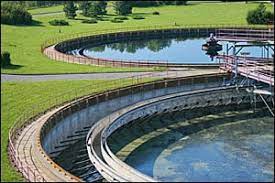Oxidation ponds are also known as stabilization ponds or lagoons. They are used for simple secondary treatment of sewage effluents. Within an oxidation pond heterotrophic bacteria degrade organic matter in the sewage which results in production of cellular material and minerals.
The production of these supports the growth of algae in the oxidation pond. Growth of algal populations allows further decomposition of the organic matter by producing oxygen.
The production of this oxygen replenishes the oxygen used by the heterotrophic bacteria. Typically oxidation ponds need to be less than 10 feet deep in order to support the algal growth.
In addition, the use of oxidation ponds is largely restricted to warmer climate regions because they are strongly influenced by seasonal temperature changes. Oxidation ponds also tend to fill, due to the settling of the bacterial and algal cells formed during the decomposition of the sewage.
Overall, oxidation ponds tend to be inefficient and require large holding capacities and long retention times. The degradation is relatively slow and the effluents containing the oxidized products need to be periodically removed from the ponds. An oxidation pond can be seen in the figure below under the key aspects of an oxidation pond application.
Read Also: Industrial Wastewater Treatment Procedure
The Key Aspects of an Oxidation Pond Application

An oxidation pond is a wastewater treatment system that utilizes natural processes to treat and purify wastewater. The term oxidation refers to the biological and chemical reactions that occur in the pond, leading to the breakdown of organic pollutants.
The oxidation pond application involves the deliberate and controlled use of these ponds as a treatment method for domestic, industrial, or agricultural wastewater. This application is based on the principles of microbiological and chemical transformations that take place within the pond environment.
Here’s a breakdown of the key aspects of an oxidation pond application:
1. Wastewater Input: Wastewater from various sources is directed into the oxidation pond for treatment. This can include sewage from residential areas, effluent from industries, or agricultural runoff.
2. Pond Design: The design of the oxidation pond is crucial to facilitate the desired treatment processes. Ponds are typically designed with specific depths, surface area, and hydraulic retention times to optimize the treatment efficiency.
3. Biological Processes: Microbial activity plays a central role in oxidation ponds. Microorganisms, including bacteria and algae, thrive in the pond environment. These microorganisms metabolize and break down organic matter present in the wastewater through processes such as aerobic and anaerobic digestion.
4. Aeration: Aeration is often employed to enhance the aerobic processes within the pond. Mechanical or natural means of introducing oxygen into the water promote the growth of aerobic bacteria, which are effective in breaking down organic pollutants.
5. Sunlight Exposure: Sunlight is a natural catalyst for various chemical and biological reactions. In oxidation ponds, sunlight promotes the growth of algae, which contribute to the removal of nutrients and play a role in oxygen production through photosynthesis.
6. Treatment Performance: Monitoring and assessing the treatment performance of oxidation ponds involve analyzing water quality parameters such as biochemical oxygen demand (BOD), chemical oxygen demand (COD), nitrogen levels, and fecal coliform counts. These indicators help gauge the effectiveness of the treatment processes.
7. Effluent Discharge: Once treated, the effluent is discharged from the oxidation pond. Depending on the specific treatment goals and regulatory requirements, the effluent may undergo further treatment or be released into receiving waters or used for irrigation.
Maintenance and Management:
Read Also: Industrial Waste-water Treatment Trickle Filters
Regular maintenance and management of oxidation ponds are essential to ensure optimal performance. This includes monitoring microbial populations, adjusting aeration levels, and addressing any factors that may impact the efficiency of the treatment process.
Overall, the oxidation pond application represents a sustainable and cost-effective approach to wastewater treatment, harnessing natural processes to mitigate environmental impacts associated with untreated or poorly treated wastewater.
In summary, from all that have been discussed, one can conclude that secondary treatment of waste-water involves the whole of tricking filters, rotating biological discs, activated sludge and oxidation pond processes.
All are aimed at improving the quality of waste-water be discharging same into the sea or on the land. Whereas most of them employ biological principles in their mechanism of operation, some employ physical processes intermittently as the processes continue.
Read Also: The Top Global Trends Driving the Fourth Agricultural Revolution

